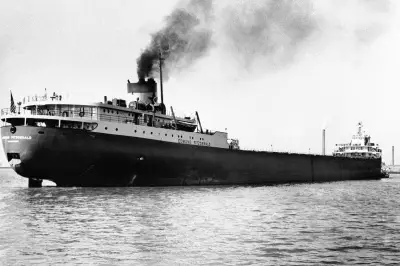
Fifty years after the most infamous disaster in Great Lakes history, the retired journalist whose news coverage helped cement the legend of the Edmund Fitzgerald shipwreck has shared his powerful account. Harry Atkins, a former Associated Press reporter, was in Detroit on 10 November 1975, when the freighter, caught in a terrifying storm, vanished into the depths of Lake Superior with all 29 crew members lost.
The Fateful Day: A Race to the Scene
Now 86 and living in Savannah, Georgia, Atkins recounted to his former employer how the news first unfolded. He was working on the AP Detroit broadcast desk when word came through from an unlikely source: an "old hermit" living near Whitefish Bay. This individual, listening to ship radio communications, alerted stations that the Fitzgerald was in grave danger.
The last message ever heard from the vessel was a transmission to a nearby ship, the Arthur Anderson, in which the captain stated, "We are holding our own." Sensing the urgency, Atkins filed a quick story and then undertook an overnight drive, covering 347 miles (559 kilometres) to Sault Ste. Marie in Michigan's Upper Peninsula.
A Bird's Eye View of the Tragedy
Upon arrival, Atkins' mission was to get to the scene. "I got the Yellow Pages," he said, "and started looking for an airplane." He secured a flight with a retired Navy pilot, flying in a small aircraft over the Canadian side of Whitefish Bay.
From the skies, a chilling sight met them. "I could see two freighters, two Coast Guard boats and one other vessel pointed at each other 'like the Chrysler star'," Atkins recalled. "So we had to figure the Fitzgerald's down there in the middle." Below, they spotted an oil slick, an empty lifeboat, and life vests. No bodies were ever recovered.
The wreck of the Edmund Fitzgerald remains today under 535 feet (165 metres) of water, approximately 17 miles (27 kilometres) from Whitefish Point, Michigan, protected as a gravesite under Canadian law.
From News Lede to Enduring Ballad
Once back on land, Atkins called his Detroit colleagues to relay his draft. His lede, the crucial first paragraph, read: "Rescuers searched Lake Superior’s chilly waters Tuesday for the 29-member crew of the sunken ore-carrier Edmund Fitzgerald but found only an oil slick, empty lifeboats and life jackets."
This news story, along with a subsequent piece in Newsweek, was read by folk singer Gordon Lightfoot. Moved by the tragedy, Lightfoot penned his haunting ballad, "The Wreck of the Edmund Fitzgerald," which was released in August 1976. The song immortalised the disaster, ensuring its place in public memory for generations.
Atkins, who later became a sports journalist, admits the song's power. "It’s a haunting ballad," he said, his voice thick with emotion. "I get choked up every time." He only fully grasped the infamy of the event he covered 25 years later, upon seeing anniversary coverage.
As family members and maritime enthusiasts gather to mark the 50th anniversary, the Edmund Fitzgerald stands as the last major shipwreck on the Great Lakes, a sombre milestone that spurred significant technological improvements in vessel safety.





